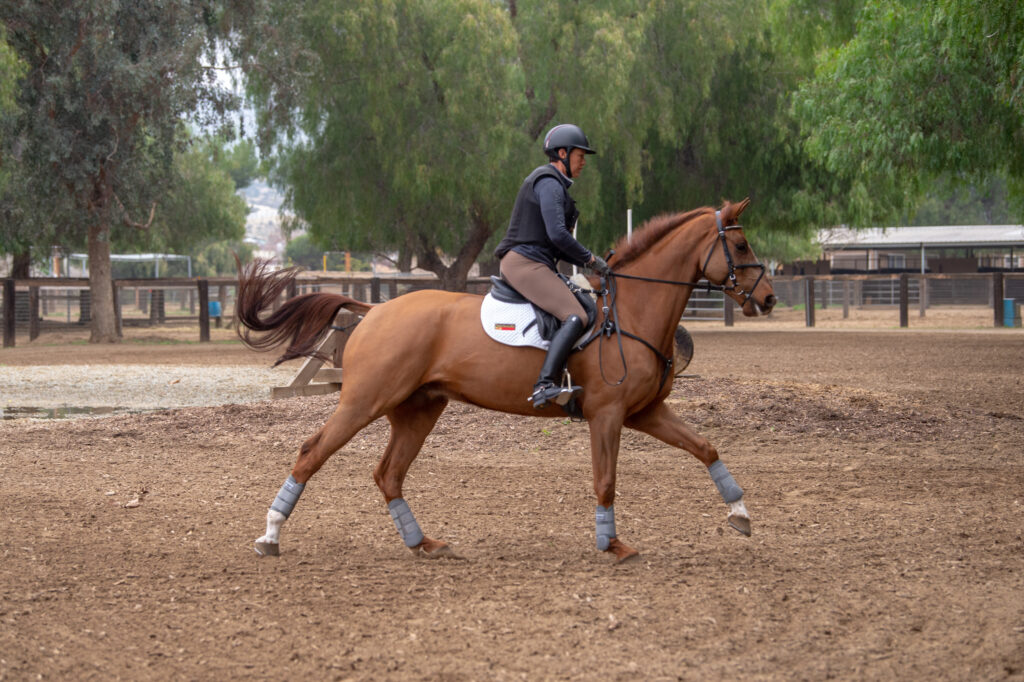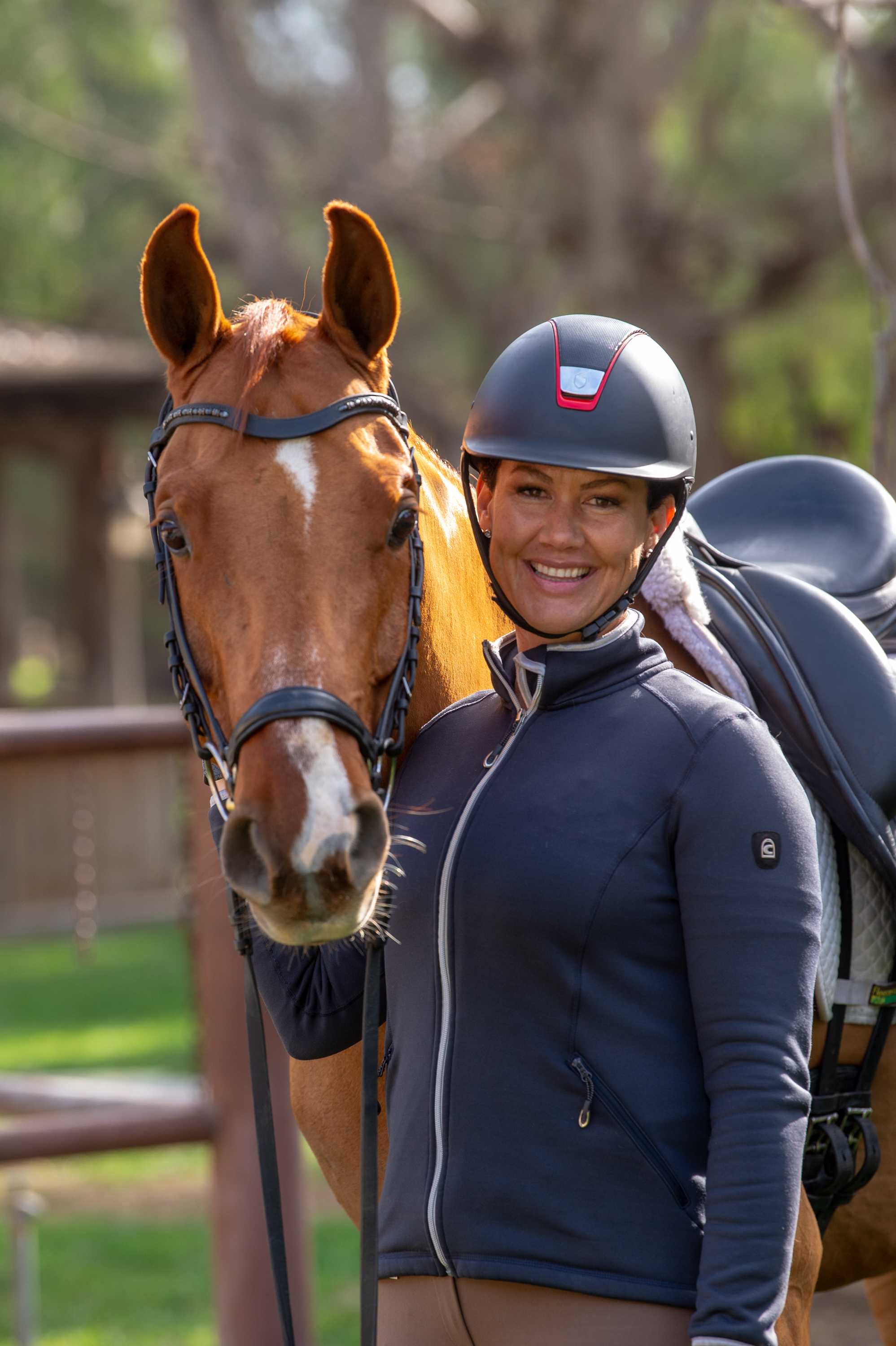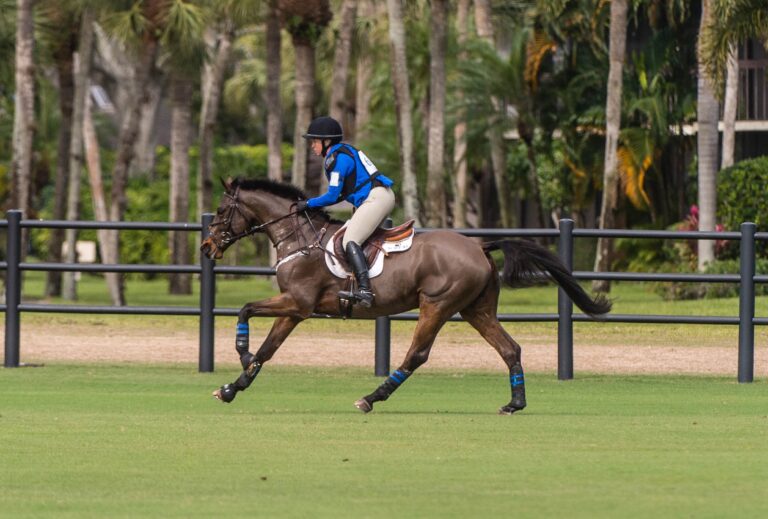There’s a reason why coffins were given such an ominous name. They’re scary—to both horses and riders! Successfully navigating the three elements of a coffin—an obstacle followed closely by a ditch and then another obstacle—is a test of bravery and rideability. That’s partly because of the optical illusion it poses. As you and your horse approach a coffin, the A element blocks your view of the ditch (the B element). Depending on the terrain and distance between the elements, the ditch doesn’t come into your horse’s view until the last minute. This can surprise him and take his attention off the task at hand: safely jumping A. Run-outs, refusals, awkward jumps and falls at A often result.

Amy K. Dragoo
Even if you manage to get over A safely, your horse’s disrupted rhythm, balance and/or line make it that much harder to jump the ditch successfully. That’s why most jumping faults occur at either A or B. The odd run-out or stop might occur at C as a consequence of these rhythm, balance and line disruptions or an organization problem (like a dropped rein, for example, resulting from a horse overjumping), but they’re not as common.
At the lower levels, appropriate questions on well-designed courses involve only half coffins—a ditch either followed by or preceded by a single, inviting obstacle, like a log, multiple strides away, so there’s more time to think and reorganize between elements—set on flat ground. As you move up the levels, the ditches widen, the terrain becomes steeper, the distances shorten to one-strides or even bounces, the straight lines are sometimes replaced with bending lines, and the obstacle types vary widely. The A and C elements can be anything from brush jumps to skinnies to corners.
Whatever your level, developing the following skills will help you jump coffins successfully:
- Teach your horse to be adjustable. This will make it easier to organize him properly in the approach. In the ring, place two jump poles about seven strides apart. Ride over the poles at a regular canter first, counting the seven strides between them. Then lengthen your horse’s stride to ride over the poles in five or six strides. Next, shorten his stride to canter over them in eight or nine strides. Keep playing with exercises like this to gradually improve his adjustability.
- Begin to develop a coffin canter. This is one of the biggest holes I see in cross-country riding. Approaching technical questions like coffins requires a slower, more controlled and compressed canter, also known as a coffin canter. To achieve this, you must get your horse forward and responsive to your leg aids without using speed or momentum. Because of the surprise aspect of coffins, merely galloping faster to them won’t guarantee good results. In fact, the faster your approach, the more likely your horse is to spook at the ditch, hit A or have trouble with the distances between the elements.
In the approach to every coffin, you must produce a clear speed and balance change. Slowing your horse down while also compressing his stride and revving his engine will give him both time to recognize the question and power to jump the elements safely. To help accomplish this, you must ask him to raise his poll and shift more of his weight onto his hind legs, thus creating a more uphill balance.
What degree of collection and uphill balance you need depends on your level. At the lower levels, you need only a slightly more collected and organized canter. At the five-star level, you need significantly more compression, shifting enough power to the hind legs to enable your horse to negotiate the more difficult obstacles and terrain.
Developing a coffin canter occurs in several stages. To begin, practice trotting small jumps in the ring. This will teach your horse to jump without relying on momentum. Then progress to the sequence of exercises in this article.
- Improve your horse’s footwork. Cantering the exact designated number of strides between coffin elements is not as important as maintaining your line and balance. The best event horses find clever ways to rearrange their legs as necessary to take off and land safely, even when the striding doesn’t work out perfectly.
Some horses are naturally better at this than others. The more things you can do at home to teach your horse to think on his feet, the better he’ll be able to negotiate tricky questions like coffins. Practice plenty of gymnastics. I use lots of small cavalletti and crossrails, especially during the off-season. For example, I sometimes build up to as many as six bounces in a row (starting with just one or two with greener horses).
These exercises will benefit you as much as your horse. Learning to ride instinctively and balance your weight over his center of gravity as he jumps through a gymnastic is an excellent skill for riding coffins. Instead of pushing him to canter the correct number of strides between the three elements—which can cause you to lose your line and have a runout—you’ll be more effective staying out of his way and letting him figure out where to put his feet. - School ditches frequently—to familiarize your horse with the concept and to get an idea of how he’s likely to behave in competition. Some horses are naturally more comfortable jumping ditches than others—but, with repeated exposure, all horses can learn to jump them confidently.
A perfect example is MB MaiStein, with whom I won the 2018 U.S. Eventing Association Young Event Horse East Coast 5-year-old Championships. Initially, he overjumped ditches dramatically, landing on his hind legs first and then snorting and running sideways. He was unbroken when I got him, so I know he never had a bad ditch experience. He was just naturally very “ditchy.” I schooled him over ditches every day leading up to the championships—even after flat sessions when I was in a dressage saddle. (For tips on riding ditches, see “Ditch Your Ditch Troubles,” by Kyle Carter, at PracticalHorsemanMag.com.)
Even at the upper levels, it’s important to refresh your horse’s familiarity with ditches frequently. If you don’t have easy access to a schooling ditch, it’s worth building a simple one, even if it’s just a shallow hole dug out behind a log on the ground. (Consult with a local course designer about how to build safe, inviting ditches.) Start with one that is small enough for your horse to step over from the walk. Then gradually work up to larger ditches. No need to practice the maximum-sized ditch for your level—or to add any terrain. The goal is not just to get to the other side of the ditch. It’s to teach your horse that he can jump ditches calmly, without over-jumping or losing his line. Especially avoid using speed to try to “hide” a ditch issue.
Some horses are easier to stay with over ditches than others. I highly recommend grabbing mane or using a neck, or grab, strap (a strap or stirrup leather looped around your horse’s neck so you can grab it with one hand over the ditch). This is the best way to ensure that you don’t lose your balance in the air and accidentally pull on the reins.
Practicing ditches frequently will reduce the unpredictability that makes riders so anxious about coffins. It’s much easier to tackle a coffin on course if you haven’t spent the previous hours worrying, “What will he do when he sees the ditch?”
When the exercises in this article (including “Full Coffin” below) are going well, gradually increase the difficulty of the full coffin by reducing the strides between the elements to one or two strides each (24 or 36 feet, respectively). Depending on how experienced you and your horse are, it might take many sessions to progress through these steps. Take your time, ask him to do only as much as he seems comfortable doing and reward him every time he gets it right.
Half Coffin: Ditch to Ground Pole
Begin with an easy half coffin with multiple strides between elements, first jumping it in the direction from the ditch to the obstacle. For your introductory half coffin, place a pair of standards, initially with a pole on the ground between them, four strides (about 60 feet) away from a ditch. Though many coffins in competition have long, straight approaches, plan to ride a turn six to ten strides before the A element during schooling. This will help to create the desired balance shift. Approach the half coffin at the canter, but then make a transition to trot before the turn. Trotting all the way up to the ditch will enable you to ride forward to it without pulling backward on the reins.
- As you approach the ditch in a nice, forward canter—as I’m demonstrating here on Marcella Ashton’s 6-year-old Irish Sport Horse Excel Star Above Authority—be sure that your lower legs are underneath you, positioned at the girth, and closed on your horse’s sides, without pinching the saddle with your knees. This will help keep your center of balance over the middle of the horse.
- Before the turn, make a transition to trot. Focusing your eyes on the B element, the pole, check that your chin is level and maintain the forward momentum with your legs as you line up with the center of the ditch.
- Keep your chin level in the air over the ditch and your eyes focused on the pole. (Never look down into the ditch!) Follow his mouth with your hands, holding them low, but keeping a light contact so you can correct him if he drifts off the line.
- Whether he lands trotting or cantering after the ditch, allow him to maintain that gait to the center of the pole. Continue to support him with your legs, but don’t rush his steps. Meanwhile, sink your weight into the saddle and keep a light rein contact.
- Over the pole, maintain your low hands, steady rein contact and level chin, while focusing your eyes ahead. Repeat this exercise until your horse feels quiet and confident.

© Amy K. Dragoo

© Amy K. Dragoo

© Amy K. Dragoo

© Amy K. Dragoo

© Amy K. Dragoo
Half Coffin: Ditch to Jump
When your horse is jumping the ditch-to-pole half coffin comfortably, build a small (2-foot) vertical between the standards and ride the ditch to the jump. This will introduce the skill of jumping an actual obstacle in the half coffin, while also progressing to the next stage in your development of the coffin canter. By now, your horse should be making a transition from canter to trot obediently before approaching the half coffin. Next ride a canter–trot–canter transition before the approach.
- Approach the half coffin in the same nice, forward canter you used previously. This time, make a transition to trot six to 10 strides before the turn (allow more time if your horse tends to be less responsive).
- After several strides of trot, pick up the canter again, all the while looking ahead to the ditch and planning your line to it.
- After jumping the ditch, focus on your line to the B element, not on the number of strides he takes. Keep your chin level and hands low all the way to the jump.

© Amy K. Dragoo

© Amy K. Dragoo

© Amy K. Dragoo
Half Coffin: Jump to Ditch
After you get the hang of the ditch-to-obstacle half coffin, try it in the reverse direction: obstacle to ditch. Start with a small ditch and a simple ground pole between jump standards, just as you did in the first exercise.
- Begin by making the same canter-trot-canter transition in the approach to the pole. Keep your eyes on the pole until you arrive at the takeoff spot; then lift your focus to a point beyond the ditch.
- Sink your weight into the saddle and concentrate on staying on your line, allowing your horse to trot or canter to the ditch.
- Before, during and after the ditch, keep your chin level, hands low and weight centered over your feet.
- Next, raise the pole to a small vertical and ride from it to the ditch in the same way, always prioritizing your line over the gait or striding.

© Amy K. Dragoo

© Amy K. Dragoo

© Amy K. Dragoo

© Amy K. Dragoo
Create a Coffin Canter
After plenty of practice making canter–trot–canter transitions in the approaches to half coffins, your horse will become accustomed to making this balance and speed change in response to your aids. Eventually, as he develops more strength and collection, you can introduce the idea of an actual coffin canter. This means that, instead of making the canter–trot–canter transition, you make the slight balance and speed change within the canter.
- Approach the A element in a regular canter, riding in your galloping position, with your hands low. Six to 10 strides before the coffin, ask your horse to compress and slow his canter slightly.
- Half-halt with your hands, thinking of lifting the bit up in his mouth, as if you were making him smile—without pulling backward on the reins. This will bring his poll higher without losing his engine’s RPMs.

© Amy K. Dragoo

© Amy K. Dragoo
Full Coffin
As your horse’s confidence grows (which can take many months), progress to a straightforward full coffin—three elements in a row. If you have access to a small, appropriately placed natural jump, like the log in this example, incorporate it into the exercise. Otherwise, build two small verticals with jump standards and poles four or five strides away (about 60 or 72 feet, respectively) on either side of the ditch.
Approach the full coffin just as you rode the half coffin, making either a canter–trot–canter transition or a balance-and-speed shift within the canter to produce more of a coffin canter six to 10 strides before the A element.
- As you near the takeoff for the A element, lower your hands. Check that your chin is level and focus your eyes on the C element, preparing to steer your horse straight on your line over B, the ditch.
- Over the ditch, keep your eyes focused on C. Don’t worry about what gait he lands in or how many strides he takes.
- Instead, concentrate on staying on your line and in the middle of your horse all the way to C.
- As you complete the coffin, keep your chin level and look ahead, ready for whatever’s next on course!

© Amy K. Dragoo

© Amy K. Dragoo

© Amy K. Dragoo

© Amy K. Dragoo
About Tamie Smith

Tamra (Tamie) Smith and Mai Baum won the 2023 Land Rover Kentucky Three-Day Event and helped the U.S. Eventing Team earn team silver at the 2022 FEI Eventing World Championship in Pratoni, Italy. Earlier that year, they finished ninth in the Badminton Horse Trials CCI5*.
In 2021, they were named the reserve for the U.S. Eventing Team for the Tokyo Olympics, and they represented the U.S. in the FEI Nations Cup at the 2021 CCIO4*-S at CHIO Aachen in Germany. In 2019, they were members of the U.S. Eventing Team that won gold at the Pan American Games in Lima, Peru. They also competed in the 2019 FEI Nations Cup in the CCIO4*-L at Boekelo in the Netherlands.
Smith has enjoyed victories with several other horses, too, including:
- 2020 USEF CCI3*-L Eventing National Champion with Elliot-V at the Galway Downs International Event
- Winner, 2021 CCI3*-S at Red Hills International (Florida) and 2021 CCI3*-L at Jersey Fresh (New Jersey) with Solaguayre California
- Winner, 2021 CCI3*-L at Galway Downs International (California) with Maitanzer
- Winner, 2022 Morven Park CCI4*-L (Virginia) with Solaguayre California
- Second, MARS Maryland 5 Star at Fair Hill CCI5*-L (Maryland) with Danito
Smith trains at Next Level Eventing in Temecula, California, with her daughter, Kaylawna Smith Cook.










